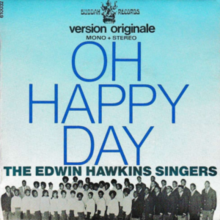Loading AI tools
Song by Edwin Hawkins Singers From Wikipedia, the free encyclopedia
"Oh Happy Day" is a 1967 gospel music arrangement of the 1755 hymn[1] by clergyman Philip Doddridge. Recorded by the Edwin Hawkins Singers, it became an international hit in 1969, reaching No. 4 on the US Singles Chart, No. 1 in France, Germany, and the Netherlands and No. 2 on the Canadian Singles Chart, UK Singles Chart, and Irish Singles Chart. It has since become a gospel music standard, selling over 7 million copies worldwide,[2][3] making it the second best-selling gospel song of all time.
| "Oh Happy Day" | ||||
|---|---|---|---|---|
 | ||||
| Single by Edwin Hawkins Singers | ||||
| from the album Let Us Go Into the House of the Lord | ||||
| B-side | "Jesus, Lover of My Soul" | |||
| Released | 1968 (April 1969, U.S.) | |||
| Recorded | 1967 | |||
| Studio | Ephesian Church of God in Christ, Berkeley, California, U.S. | |||
| Genre | ||||
| Length | 4:59 | |||
| Label | Pavilion/Buddah | |||
| Songwriter(s) | Edwin Hawkins, based on 1775 hymn | |||
| Producer(s) | Edwin Hawkins | |||
| Edwin Hawkins Singers singles chronology | ||||
| ||||
| Official audio | ||||
| "Oh Happy Day" on YouTube | ||||
The recording begins with a muted piano, drum, and bass, backing lead singer Dorothy Combs Morrison on the left-hand stereo channel, then alternates twice with a full-throated chorus that includes a large ensemble, rising to a crescendo with handclaps, and ending with a return to the muted sound as at the beginning. The track is notable for its clear sound given the powerful vocals and the modest equipment used to capture them. It was made at Hawkins' church, the Ephesian Church of God in Christ in Berkeley, California.[4]
The gospel style arrangement of the hymn "Oh, Happy Day" by Edwin Hawkins has a long pedigree. It began as a hymn, written in the mid-18th century ("O happy day, that fixed my choice"), by English clergyman Philip Doddridge (based on Acts 8:35) set to a 1704 melody by J. A. Freylinghausen.[5] By the mid-19th century it had been given a new melody by Edward F. Rimbault, who also added a chorus,[6] and was commonly used for baptismal or confirmation ceremonies in the UK and USA. The 20th century saw its adaptation from 3
4 to 4
4 time and this new arrangement by Hawkins, which contains only the repeated Rimbault refrain, with all of the original verses being omitted.
The B-side of the single was Hawkins' own modern arrangement of "Jesus, Lover of My Soul" originally written by Charles Wesley in 1740.[7][8]
Hawkins rearranged the hymn to give it more of a gospel feel, and devised a piano introduction which he said was influenced by the music of Sérgio Mendes. When the choir made the recording in 1967, lead singer Dorothy Morrison added some lyrical improvisations influenced by James Brown, which, she said, "made the song feel even more current".[9]
Hawkins' arrangement quickly became a “standard” and has been recorded by hundreds of artists. It was included on the RIAA Songs of the Century list and won Hawkins a Grammy Award for Best Soul Gospel Performance in 1970 (performed by the Edwin Hawkins Singers).[10]
In 2005, "Oh Happy Day" was one of 50 recordings chosen that year by the Library of Congress to be added to the National Recording Registry.[11]
In live performances and acoustic versions of the Nick Cave song "Deanna" (1988), portions of "Oh Happy Day" are included, revealing the inspiration for Cave's song.[12] George Harrison has stated the song was a primary inspiration in the writing of his 1970 international hit single "My Sweet Lord."[13][14]
The song has appeared in many movies, beginning with the German film Seventeen and Anxious in 1970, but most notably Whoopi Goldberg's Sister Act 2,[15] with then 14-year-old Ryan Toby singing lead. The song also appears in Big Momma's House,[16] Nutty Professor II: The Klumps,[17] David LaChapelle's 2005 movie Rize,[18] Robin Williams’s 2007 movie License to Wed,[19] the 2010 biographical film produced by Walt Disney Pictures: Secretariat (played when Secretariat wins the Belmont), and Spike Lee's BlacKkKlansman.
The Edwin Hawkins Singers' performance of the song at the 1969 Harlem Cultural Festival appears in the 2021 music documentary, Summer of Soul.[14]
The song is regularly performed by space-rock band Spiritualized as the last song of their live sets.[20]
The song was also included on the album Let Us Go Into the House of the Lord (1968).[21] It was released as a 7-inch single on Pavilion Records in April 1969,[22] then on the Buddah Records album It's a Happy Day also in 1969.[23]
Weekly charts
|
Year-end charts
|
| Region | Certification | Certified units/sales |
|---|---|---|
| United States (RIAA)[51] | Gold | 1,000,000^ |
|
^ Shipments figures based on certification alone. | ||
Seamless Wikipedia browsing. On steroids.
Every time you click a link to Wikipedia, Wiktionary or Wikiquote in your browser's search results, it will show the modern Wikiwand interface.
Wikiwand extension is a five stars, simple, with minimum permission required to keep your browsing private, safe and transparent.